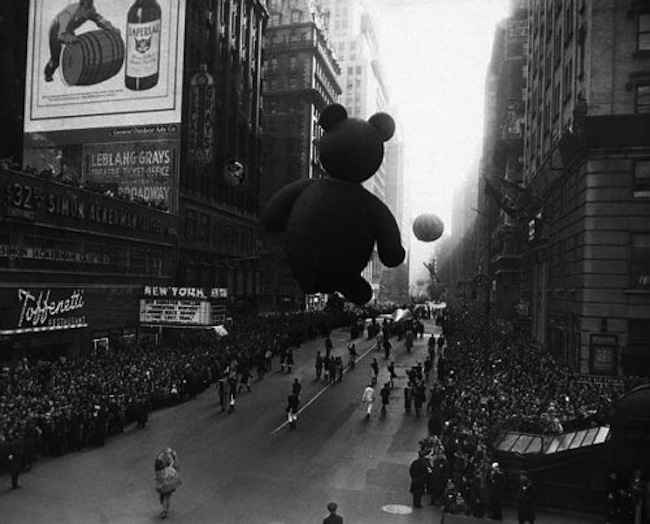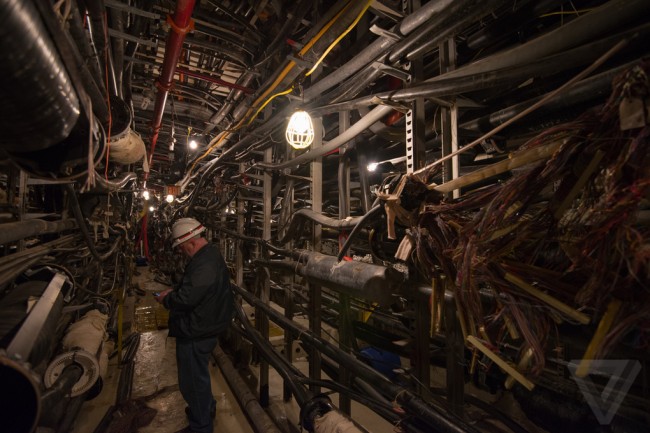
We are celebrating 15 years — and counting — of stories that are deeply researched and deeply felt, that build a historical record of what the city has been.
We are celebrating 15 years — and counting — of stories that are deeply researched and deeply felt, that build a historical record of what the city has been.
The enormity of recent and current events — natural disasters and a presidential election at home, intensifying violence abroad — make for an odd Thanksgiving. While those of us with habitable homes and flowing electricity have plenty to be thankful for, retailers are concerned that this gratitude might not translate into the sales expected from Black Friday, so they’re upping their game. The days when a department store’s response to a holiday was to invest in the pageantry and public assembly of an urban parade seem long ago and far away.

Macy’s Thanksgiving Day Parade ca. 1930 | For this and more historical images of the annual parade, visit Black Watch
PLANES, TRAINS and AUTOMOBILES
Besides retail’s steady creep into even more of the holiday weekend, another annual ritual we’ve come to expect this week is the clogging of all transportation routes. To facilitate shared rides from Brooklyn with fixed costs to New York City airports, Weeels set up a simple form for users to input their information and applied a new algorithm to connect travelers leaving at similar times. The service is now closed, but reminds us of the excess capacity hidden in our vehicle-based, private transportation system.
For those of us driving to our Thanksgiving destinations, be sure to notice that many of the rest stops and food and fuel service areas that line the interstates have gotten a facelift in recent years. This observation prompted a delightful piece in The Washington Post that describes the history and evolution of the rest stop from roadside picnic tables into welcome centers touting state attractions, from sketchball restrooms into high-tech travel plazas.
CITIES ON THE CLIFF
The highway system, it seems, is an area of federal spending so precious as to be heavily insulated from from the automatic cuts to spending that will go into effect early next year if Congress and President Obama fail to come to an agreement about how to reduce the deficit. The official term for what the media is calling “the fiscal cliff” and what journalist Annie Lowrey named the “Debtpocalpse” is budget sequestration. What it means, regardless of its name, is enforced austerity — half a trillion dollars in tax increases and spending cuts — that, according to the Office of Management and Budget (OMB), was “never intended to be implemented.” On The Atlantic Cities, Eric Jaffe offers a succinct analysis of what it would mean for cities, closely reading an OMB report on the “‘devastating impact’ sequestration will have on roughly 1,200 specific budget lines.
First off, the Department of Housing and Urban Development will take a hit, with its $4 billion operating fund for public housing reduced to around $325 million, and overall funding for housing programs will be reduced by 8%. The Federal Transit Administration will see its administrative costs and capital grants go down, and Amtrak and TSA too will receive cuts in funding to their programs. Highways are somewhat immune — since the Highway Trust Fund is exempt from sequestration — but not out of reach. If the trust needs to supplement costs in the future, it will have to do so by borrowing money from the general taxpayer fund. Of course, cuts mean layoffs and fewer jobs, both of which Obama has prioritized avoiding. But reductions in federal spending also translate, according to the US Conference of Mayors, into higher costs for local governments. So a group of mayors pled their case on Capitol Hill this week, imploring national lawmakers to understand the local implications of congressional intransigence.
MAYORS CHALLENGE
The notion that cities have their own ideas about how to innovate in governmental service delivery lies behind the Mayors Challenge, Bloomberg Philanthropies’ $9 million contest to reward and invest in new, big ideas coming out of city halls across the country. Out of an applicant pool of 300 cities, 20 finalists have been chosen, based on the criteria of “boldness, strength of planning, potential for impact, and replicability.” The projects differ widely in the problems they intend to solve. For example, Houston, Texas, has proposed to create a new technology that will automatically sort trash and recycling, taking the responsibility out of the hands of its residents. Providence, Rhode Island, on the other hand, wants to build on home visitation services to “equip every family in Providence with the new technology and coaching necessary to measure their child’s household auditory environment and intervene to close vocabulary deficits in real time.” James Anderson, director of the program, described, “These 20 finalists represent the very best, showcasing the creativity and pragmatism that Americans expect from their local leaders.” These cities will now hone their proposals and compete for the $5 million grand prize and four $1 million awards.

The cable vault at the Verizon Broad Street Central Office spans an area 150 feet long and 40 feet wide. The storm surge filled it to the top for nearly two days. | via The Verge
SANDY AFTERMATH
As New York continues to recover from Sandy, the Buildings Department has announced that around 200 homes damaged during the storm on Staten Island, in Queens and in Brooklyn pose a public safety threat and need to be demolished in the coming weeks and months. The majority are one and two-family houses, many of which were built over a half-century ago, but there have been no decisions made yet about rebuilding in these areas.
The bulldozed homes and the remains of other destroyed structures will be cleared away and added to the overwhelming mountain of debris and waste currently in temporary landfills in such places as the parking lots of Jacob Riis Park in the Rockaways, and, once again, Fresh Kills. The Department of Sanitation and the Army Corps of Engineers are working hand-in-hand to continue the cleanup effort, which has transformed into a “24-hour-a-day, military-scale operation.” The Department estimated that roughly 250,000 tons of debris has been picked up from New York City alone, much of which is headed to Seneca Meadows landfill in Waterloo, NY.
Federal money continues to pour in to help New York and other recovering states get back on their feet post-Sandy. The amount could potentially exceed $30 billion, half of which will most likely be used to rebuild damaged infrastructure in the same disaster-prone areas. “Tax money will go toward putting things back as they were, essentially duplicating the vulnerability that existed before the hurricane,” write Just Gillis and Felicity Barringer in The New York Times. Instead of subsidizing these projects, scientists, lawmakers, and advocacy groups argue that the funds should be used to reduce vulnerabilities in the short run, and assist in the withdrawal of at-risk shoreline towns in the long run.
These structural, legal, and cultural disincentives to withdraw from flood plains and barrier islands is one of the many challenges that Michael Kimmelman points to in his plaintive post-Sandy article, which connects the design and engineering quandaries ahead to grand projets of the past, like Robert Moses’ failed attempt to build the Westway, and some of the newly resilient shorelines of today, like Brooklyn Bridge Park.
Of course, housing and future flood prevention measures aren’t the only infrastructures that demand attention in Sandy’s evolving aftermath. To help return transportation access to the Rockaways while the MTA repairs and rebuilds the extensively-damaged A train tracks, the H train, an on-again-off-again part of the subway system since 1956, is back in effect. The shuttle line will run, free of charge, from 4am to 1am daily, from Far Rockaway-Mott Avenue to Beach 90-Holland station. A shuttle bus then takes riders from Far Rockaway to Howard Beach, where the A train currently terminates. Check out a video above of the MTA’s Fleet Operations team trucking the cars from Ozone Park to the Rockaways — the tracks in between are too damaged to allow passage — and reinstalling them over the course of a four-night operation.
And for infrastructural challenges underground, The New York Times looks at the complex engineering challenges of a relatively inexpensive way to prevent tunnel flooding in future storms, an “airbag in a tunnel” that can keep floodwaters at bay. And The Verge went inside the 90,000-cubic-foot Verizon cable vault at Broad Street to see the “catastrophic” damage done to the copper cable infrastructure that brings phone and internet to much of Lower Manhattan, and to hear how Verizon is taking the opportunity to upgrade its fiber optic network, which is more resilient to flooding than copper wiring.
RIDGEWOOD RADIATION
But lest we think stronger storms are our only environmental challenge these days, good old fashioned toxic waste is still making headlines. DNAinfo reports that the EPA is taking the lead on a radiation abatement effort in Ridgewood, Queens. Formerly home to the Wolff-Alport Chemical Company, 1125 – 1139 Irving Avenue was the site of work connected to the Manhattan Project during World War II. The site’s facilities processed monazite sand to “extract rare earth elements, leaving thorium and to a lesser degree uranium byproducts.” Those byproducts were dumped in local sewers and “other wastes may have been buried onsite.” Residual radioactive contamination, discovered by the City through a 2007 study, is said to pose “no immediate threat” to the community, but concerns about long-term exposure are driving mitigation efforts and further testing. Ridgewood isn’t the only local site showing evidence of its nuclear past — look back at Elizabeth Ellsworth and Jamie Kruse’s 2010 UO feature, “Geologic City,” in which the pair visit a former uranium storage site in Richmond Terrace, Staten Island, where radiation levels have been recorded at 200 times the level required to prompt a cleanup.
The Roundup keeps you up to date with topics we’ve featured and other things we think are worth knowing about.
The views expressed here are those of the authors only and do not reflect the position of The Architectural League of New York.